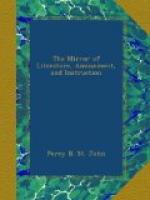The funeral pall of Sir W. Walworth curiously embroidered with gold, is preserved amongst the relics, as well as a plan of the splendid show at his installation, 1380.
The Fishmongers’ Company is fourth upon the list of the city corporations, under the name and style of “the Wardens and Commonalty of the mystery of Fishmongers of the city of London.” It is a livery company, and very rich, governed by a prime and five other wardens, and a court of assistants.
The company supports a free Grammar School at Holt Market, in Norfolk, founded by Sir John Gresham; Jesus Hospital, at Bray, in Berkshire, founded by William Goddard, Esq. for forty poor persons; St. Peter’s Hospital, near Newington, Surrey, founded by the company; twelve alms-houses at Harrietsham, in Kent, founded by Mr. Mark Quested; a fellowship in Sidney-Sussex College, Cambridge founded by Mr. Leonard Smith; a scholarship in the same college, founded by William Bennet, Esq. Mr. Smith, executor.
The Arms of the Company are in a shield supported by a merman and mermaid, the latter with a mirror in her hand. The Keys refer to St. Peter, the Patron Saint of the Company.
[1] Quoted by Cunningham in his “Life of Wren,”
from a contemporary
authority.
[2] Wards of London.
* * * * *
HOLY SEPULCHRE, HECKINGTON CHURCH.
(To the Editor.)
From the description of the Holy Sepulchre in Heckington Church, given in your last volume, stating that it stood there in the summer of 1789, such of your readers as have no means of knowing to the contrary, may infer that it is not now in existence.[1] I am led to trouble you with a few lines on the subject, as this specimen still in the best preservation, deserves us full an account as your limits will admit. The sepulchre nearly, and the stalls also mentioned by you, which have been cleaned completely, remain now in the same state as the artist originally left them. An architect, Mr. T. Rickman, who visited the neighbourhood a short time ago, gives the following account, which was printed in a work[2] on the topography of the neighbourhood, soon after his visit: he says, “The sepulchre, of which there are not many specimens now remaining, consists of a series of richly ornamented niches, the largest of which represents the tomb, having angels standing beside it; the side niches have the Maries and other appropriate figures, and in the lower niches are the Roman soldiers reposing; these niches have rich canopies, and are separated by buttresses and rich finials, having all the spaces covered by very rich foliage.” He further observes, that “the stalls exhibit a specimen of pure decorated work, as rich as the finest sculpture of foliage and small figures can render it, and hardly surpassed by any in the kingdom, and the sepulchre is of the same excellent character. The various small ornaments about these stalls and niches form one of the best possible studies for enrichments of this date: and it is almost peculiar to this church, that there is nothing about it, except what is quite modern, that is not of the same style of architecture.”




